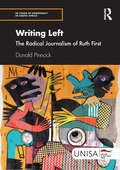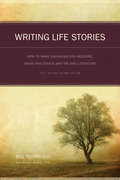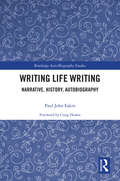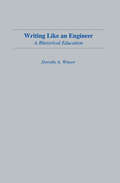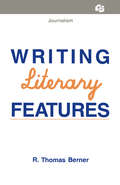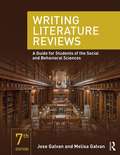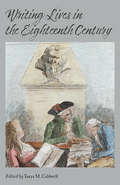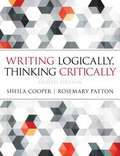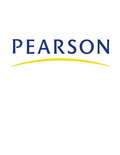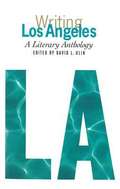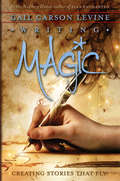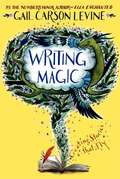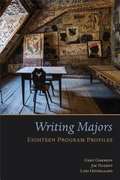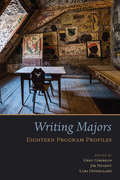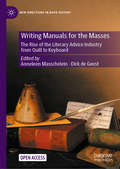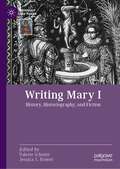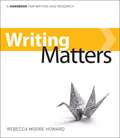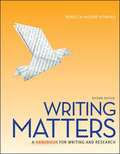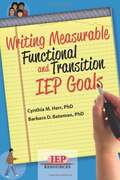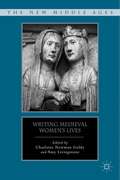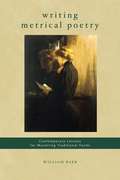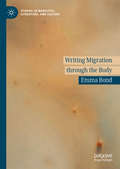- Table View
- List View
Writing Left: The Radical Journalism of Ruth First (30 Years of Democracy in South Africa)
by Donald PinnockThis book presents a detailed study of the political journalism of Ruth First – an independent thinker and a headstrong journalist who stood her ground in a male-dominated liberation movement. A product of information gathering which began in South Africa in 1986 (at a time when discussing communism exposed one to the possibility of imprisonment without trial), the subject matter in this book discusses her unwavering commitment and contribution to a free press. Print editions not for sale in Sub-Saharan Africa. This book is part of Routledge’s co-published series 30 Years of Democracy in South Africa, in collaboration with UNISA Press, which reflects on the past years of a democratic South Africa and assesses the future opportunities and challenges.
Writing Life Stories: How to Make Memories into Memoirs, Ideas into Essays, and Life into Literature - Fully Revised Second Edition
by Bill Roorbach Kristen KecklerHow to Make Memories into Memoirs, Ideas into Essays, and Life into Literature From drawing a map of a remembered neighborhood to signing a form releasing yourself to take risks in your work, Roorbach offers innovative techniques that will trigger ideas for all writers. Writing Life Stories is a classic text that appears on countless creative nonfiction and composition syllabi the world over. This updated 10th anniversary edition gives you the same friendly instruction and stimulating exercises along with updated information on current memoir writing trends, ethics, internet research, and even marketing ideas. You'll discover how to turn your untold life stories into vivid personal essays and riveting memoirs by learning to open up memory, access emotions, shape scenes from experience, develop characters, and research supporting details. This guide will teach you to see your life more clearly and show you why real stories are often the best ones.
Writing Life Writing: Narrative, History, Autobiography (Routledge Auto/Biography Studies)
by Paul John EakinWhy do we endlessly tell the stories of our lives? And why do others pay attention when we do? The essays collected here address these questions, focusing on three different but interrelated dimensions of life writing. The first section, "Narrative," argues that narrative is not only a literary form but also a social and cultural practice, and finally a mode of cognition and an expression of our most basic physiology. The next section, "Life Writing: Historical Forms," makes the case for the historical value of the subjectivity recorded in ego-documents. The essays in the final section, "Autobiography Now," identify primary motives for engaging in self-narration in an age characterized by digital media and quantum cosmology.
Writing Like An Engineer: A Rhetorical Education (Rhetoric, Knowledge, and Society Series)
by Dorothy A. WinsorComprised of a study spanning over five years, this text looks at four engineering co-op students as they write at work. Since the contributors have a foot in both worlds -- work and school -- the book should appeal to people who are interested in how students learn to write as well as people who are interested in what writing at work is like. Primarily concerned with whether engineers see their writing as rhetorical or persuasive, the study attempts to describe the students' changing understanding of what it is they do when they write. Two features of engineering practice that have particular impact on the extent to which engineers recognize persuasion are identified: * a reverence for data, and * the hierarchical structure of the organizations in which engineering is most commonly done. Both of these features discourage an open recognition of persuasion. Finally, the study shows that the four co-op students learned most of what they knew about writing at work by engaging in situated practice in the workplace, rather than by attending formal classes.
Writing Literary Features (Routledge Communication Series)
by R. Thomas BernerFirst Published in 1988. Routledge is an imprint of Taylor & Francis, an informa company.
Writing Literature Reviews: A Guide for Students of the Social and Behavioral Sciences
by Jose GalvanAs the title implies, this author provides step-by-step instructions in conceptualizing and writing a literature review.
Writing Literature Reviews: A Guide for Students of the Social and Behavioral Sciences (Seventh Edition)
by Jose L. Galvan Melisa C. GalvanThis useful guide educates students in the preparation of literature reviews for term projects, theses, and dissertations. The authors provide numerous examples from published reviews that illustrate the guidelines discussed throughout the book.
Writing Lives in the Eighteenth Century (Aperçus: Histories Texts Cultures)
by Peter Sabor Marilyn Francus James J. Caudle Lisa Berglund Victoria Warren Todd GilmanWriting Lives in the Eighteenth Century is a collection of essays on memoir, biography, and autobiography during a formative period for the genre. The essays revolve around recognized male and female figures—returning to the Boswell and Burney circle—but present arguments that dismantle traditional privileging of biographical modes. The contributors reconsider the processes of hero making in the beginning phases of a culture of celebrity. Employing the methodology William Godwin outlined for novelists of taking material “from all sources, experience, report, and the records of human affairs,” each contributor examines within the contexts of their time and historical traditions the anxieties and imperatives of the auto/biographer as she or he shapes material into a legacy. New work on Frances Burney D’Arblay’s son, Alexander, as revealed through letters; on Isabelle de Charriere; on Hester Thrale Piozzi; and on Alicia LeFanu and Frances Burney’s realignment of family biography extend current conversations about eighteenth century biography and autobiography. Published by Bucknell University Press. Distributed worldwide by Rutgers University Press.
Writing Logically, Thinking Critically
by Sheila Cooper Rosemary PattonThis concise, accessible text teaches students how to write logical, cohesive arguments and how to evaluate the arguments of others. Integrating writing skills with critical thinking skills, this practical book teaches students to draw logical inferences, identify premises and conclusions and use language precisely. Students also learn how to identify fallacies and to distinguish between inductive and deductive reasoning. Ideal for any composition class that emphasizes argument, this text includes coverage of writing style and rhetoric, logic, literature, research and documentation.
Writing Logically, Thinking Critically
by Sheila Cooper Rosemary PattonThis concise, accessible text teaches students how to write logical, cohesive arguments and how to evaluate the arguments of others. Integrating writing skills with critical thinking skills, this practical book teaches students to draw logical inferences, identify premises and conclusions and use language precisely. Students also learn how to identify fallacies and to distinguish between inductive and deductive reasoning. Ideal for any composition class that emphasizes argument, this text includes coverage of writing style and rhetoric, logic, literature, research and documentation.
Writing Logically, Thinking Critically (6th Edition)
by Sheila Cooper Rosemary PattonThis concise, accessible text teaches students how to write logical, cohesive arguments and how to evaluate the arguments of others. Integrating writing skills with critical thinking skills, this practical book teaches students to draw logical inferences, identify premises and conclusions and use language precisely. Students also learn how to identify fallacies and to distinguish between inductive and deductive reasoning. Ideal for any composition class that emphasizes argument, this text includes coverage of writing style and rhetoric, logic, literature, research and documentation.
Writing Los Angeles: A Literary Anthology (A Library Of America Special Publication)
by David L. UlinIn this book, The Library of America presents a glittering panorama of the city, encompassing fiction, poetry, essays, journalism, and diaries by over seventy writers. This revelatory anthology brings to life the entrancing surfaces and unsettling contradictions of the City of Angels, from Raymond Chandler’s evocation of the murderous moods fed by the Santa Ana winds to John Gregory Dunne’s affectionate tribute to “the deceptive perspectives of the pale subtropical light.” Here are fascinating strata of Los Angeles’s cultural and social history, from the oil boom of the 1920s to the graffiti artists of the 1980s, from flamboyant evangelist Aimee Semple MacPherson to surf music genius Brian Wilson, from the German émigré intellectuals chronicled by Salka Viertel to the hard-bitten homicide cops tracked by James Ellroy. Here are its fragile ecosystems, its architectural splendors, and its social chasms, in the words of writers as various as M.F.K. Fisher, William Faulkner, Bertolt Brecht, Evelyn Waugh, Octavio Paz, Joan Didion, Walter Mosley, and Mona Simpson. Art Pepper discovers Central Avenue in the heyday of the 1940s jazz scene; Charles Mingus describes an early encounter with the builder of the Watts Towers; screenwriter Robert Towne reflects on the origins of Chinatown; John McPhee powerfully conveys the devastation of Los Angeles mudslides; David Hockney teaches himself how to drive in record time; and Pico Iyer finds at Los Angeles International Airport “as clear an image as exists today of the world we are about to enter.” This book is an incomparable literary tour guide to a city of shifting identities and endless surprises.
Writing Magic
by Gail Carson LevineDo you want to write stories that catch your readers and never let go? Have you ever wondered how to create a book as magical as Ella Enchanted, as touching as Dave at Night, as captivating as Fairest? Well, now you can find out! In Writing Magic, Newbery Honor author Gail Carson Levine shares her secrets of great writing. She shows how you, too, can get terrific ideas for stories, invent great beginnings and endings, write sparkling dialogue, develop memorable characters-;and much, much more. She advises you about what to do when you feel stuck-;and how to use helpful criticism. Best of all, she offers writing exercises that will set your imagination on fire. With humor, honesty, and wisdom, Gail Carson Levine shows you that you, too, can make magic with your writing.
Writing Magic: Creating Stories That Fly
by Gail Carson LevineNewbery Honor author Gail Carson Levine shares her discoveries for writing exciting stories.
Writing Majors
by Lori Ostergaard Greg Giberson Jim NugentThe writing major is among the most exciting scenes in the evolving American university. Writing Majors is a collection of firsthand descriptions of the origins, growth, and transformations of eighteen different programs. The chapters provide useful administrative insight, benchmark information, and even inspiration for new curricular configurations from a range of institutions.A practical sourcebook for those who are building, revising, or administering their own writing majors, this volume also serves as a historical archive of a particular instance of growth and transformation in American higher education. Revealing bureaucratic, practical, and institutional matters as well as academic ideals and ideologies, each profile includes sections providing a detailed program review and rationale, an implementation narrative, and reflection and prospection about the program.Documenting eighteen stories of writing major programs in various stages of formation, preservation, and reform and exposing the contingencies of their local and material constitution, Writing Majors speaks as much to the "how to" of building writing major programs as to the larger "what," "why," and "how" of institutional growth and change.
Writing Majors: Eighteen Program Profiles
by Lori Ostergaard Greg Giberson Jim NugentThe writing major is among the most exciting scenes in the evolving American university. Writing Majors is a collection of firsthand descriptions of the origins, growth, and transformations of eighteen different programs. The chapters provide useful administrative insight, benchmark information, and even inspiration for new curricular configurations from a range of institutions. A practical sourcebook for those who are building, revising, or administering their own writing majors , this volume also serves as a historical archive of a particular instance of growth and transformation in American higher education. Revealing bureaucratic, practical, and institutional matters as well as academic ideals and ideologies, each profile includes sections providing a detailed program review and rationale, an implementation narrative, and reflection and prospection about the program. Documenting eighteen stories of writing major programs in various stages of formation, preservation, and reform and exposing the contingencies of their local and material constitution, Writing Majors speaks as much to the “how to” of building writing major programs as to the larger “what,” “why,” and “how” of institutional growth and change.
Writing Manuals for the Masses: The Rise of the Literary Advice Industry from Quill to Keyboard (New Directions in Book History)
by Anneleen Masschelein Dirk De GeestThis open access collection of essays examines the literary advice industry since its emergence in Anglo-American literary culture in the mid-nineteenth century within the context of the professionalization of the literary field and the continued debate on creative writing as art and craft. Often dismissed as commercial and stereotypical by authors and specialists alike, literary advice has nonetheless remained a flourishing business, embodying the unquestioned values of a literary system, but also functioning as a sign of a literary system in transition. Exploring the rise of new online amateur writing cultures in the twenty-first century, this collection of essays considers how literary advice proliferates globally, leading to new forms and genres.
Writing Mary I: History, Historiography, and Fiction (Queenship and Power)
by Valerie Schutte Jessica S. HowerThis book—along with its companion volume Mary I in Writing: Letters, Literature, and Representations—centers on representations of Queen Mary I in writing, broadly construed, and the process of writing that queen into literature and other textual sources. It spans an equally wide chronological and geographical scope, accounting for the years prior to her accession in July 1553 through the centuries that followed her death in November 1558 and for her reach across England, and into Ireland, Spain, Italy, Russia, and Africa. Its intent is to foreground words and language—written, spoken, and acted out—and, by extension, to draw out matters of and conversations about rhetoric, imagery, methodology, source base, genre, narrative, form, and more. Taken together, these volumes find in England’s first crowned queen regnant an incomparable opportunity to ask new questions and seek new answers that deepen our understanding of queenship, the early modern era, and modern popular culture.
Writing Matters: A Handbook for Writing and Research
by Rebecca Moore HowardWriting Matters unites research, reasoning, documentation, grammar and style in a cohesive whole, helping students see the conventions of writing as a network of responsibilities writers have.
Writing Measurable Functional and Transition IEP Goals
by Barbara D. Bateman Cynthia M. HerrWriting Measurable Functional and Transition IEP Goals is a new book by the leading IEP author team! Students with severe and multiple disabilities typically do not get sufficient, direct, individual instruction in functional and transition skills areas. These include social skills, communication, transportation training, leisure-recreation, self-care, housekeeping, and many others. This lack of functional skill training can also be a problem for those with moderate or mild disabilities. This book addresses all these groups with its focus squarely on two instructional steps: writing measurable goals (target behaviors,) and identifying steps on the way to those goals (task analysis). It is patterned after the coauthors' highly successful and definitive book, Writing Measurable IEP Goals and Objectives, but emphasizes functional goals for transition students.
Writing Medieval Women’s Lives
by Amy Livingstone Charlotte Newman GoldyA collection of essays representing the growing variety of approaches used to write the history of medieval women. They reflect the European medieval world socially, geographically and across religious boundaries, engaging directly with how the medieval women's experience wa reconstructed, as well as what the experience was.
Writing Metamorphosis in the English Renaissance
by Susan WisemanTaking Ovid's Metamorphoses as its starting point, this book analyses fantastic creatures including werewolves, bear-children and dragons in English literature from the Reformation to the late seventeenth century. Susan Wiseman tracks the idea of transformation through classical, literary, sacred, physiological, folkloric and ethnographic texts. Under modern disciplinary protocols these areas of writing are kept apart, but this study shows that in the Renaissance they were woven together by shared resources, frames of knowledge and readers. Drawing on a rich collection of critical and historical studies and key philosophical texts including Descartes' Meditations, Wiseman outlines the importance of metamorphosis as a significant literary mode. Her examples range from canonical literature, including Shakespeare's A Midsummer Night's Dream and The Tempest, to Thomas Browne on dragons, together with popular material, arguing that the seventeenth century is marked by concentration on the potential of the human, and the world, to change or be changed.
Writing Metrical Poetry: Contemporary Lessons For Mastering Traditional Forms
by William BaerWrite poetry in the great metrical tradition of Dante, Shakespeare, Dickinson, Frost, and the poets of the current Formalist revival. In this contemporary guide, you'll learn how to write metrical poetry in all the major forms, from blank verse and quatrains to sonnets and villanelles. Each chapter provides step-by-step instruction that's accessible and easy to understand for even the beginning poet.
Writing Migration through the Body (Studies in Mobilities, Literature, and Culture)
by Emma BondWriting Migration through the Body builds a study of the body as a mutable site for negotiating and articulating the transnational experience of mobility. At its core stands a selection of recent migration stories in Italian, which are brought into dialogue with related material from cultural studies and the visual arts. Occupying no single disciplinary space, and drawing upon an elaborate theoretical framework ranging from phenomenology to anthropology, human geography and memory studies, this volume explores the ways in which the skin itself operates as a border, and brings to the surface the processes by which a sense of place and self are described and communicated through the migrant body. Through investigating key concepts and practices of transnational embodied experience, the book develops the interpretative principle that the individual bodies which move in contemporary migration flows are the primary agents through which the transcultural passages of images, emotions, ideas, memories – and also histories and possible futures – are enacted.
